Annual Report 2018-19: Building tomorrow’s public service today

Table of contents
- Message from the Commissioners
- Renewal and preparing for the future
- Advancing diversity and inclusion
- Persons with a priority entitlement and veterans
- Modernizing public service staffing
- A public service based on merit and non-partisanship
- Non-partisanship and political activities
- Moving forward
- Endnotes
Message from the Commissioners


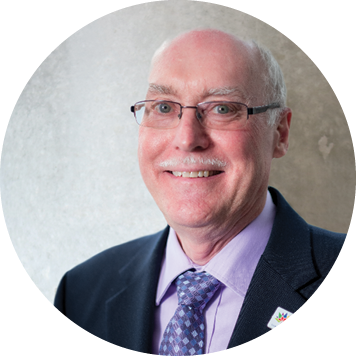
The Canadian public service continues to receive international recognition as one of the highest-performing and most effective in the world. This success is made possible by the thousands of public servants in departments and agencies across the country dedicated to providing professional and quality services to Canadians. We are justifiably proud of the role that the Public Service Commission of Canada plays in shaping this world-leading public service. Through policy direction, oversight and staffing and assessment services, we safeguard merit-based appointments and protect the non-partisan nature of the federal public service.
We live in a dynamic time, with ever-evolving technology, new ways of working, fierce competition for talent and the changing expectations of new generations of employees. In this context, we need to hire not only for current knowledge and skills, but also for the ability to learn, adapt and develop for an unknown future. To help the public service as a whole hire this talent more quickly, the Public Service Commission is actively working with departments and agencies to decrease the time that it takes to staff positions.
We also need to be more agile and responsive to today’s environment. To accomplish this, the Public Service Commission launched a modernized policy framework in 2016. The goal was to simplify staffing by reducing the administrative burden on departments and agencies, and to offer them more flexibility to customize staffing to better meet their day-to-day realities and changing needs. Three years later, we are seeing signs of improvement and increased innovation in staffing. Departments and agencies are striving to modernize their recruitment efforts, and to shift how they attract and recruit new talent. We are pleased to share some of these noteworthy practices in this year’s report, and to highlight just a small sample of the innovative methods being introduced across government.
Despite this progress, departments and agencies have yet to fully embrace this new foundation, and innovation is not yet leading to systemic change. The Public Service Commission’s report on the Staffing and Non-Partisanship Survey raises concerns related to employee perceptions of the staffing process, and it highlights the lingering solitudes between hiring managers, human resources professionals and employees. There is still much work to do be done in order to ensure all stakeholders are comfortable with staffing under this new policy framework, and the Public Service Commission will continue to work with its partners to fundamentally transform public service hiring.
This year saw the completion of Susan Cartwright’s term as Commissioner of the Public Service Commission. Ms. Cartwright joined us in 2012 after an accomplished 31-year career in the public service. Before joining us, she led the legislative review of the Public Service Modernization Act. This provided her with a unique perspective and profound knowledge of staffing, and her invaluable guidance will be missed. We would like to thank Ms. Cartwright for her contribution to the Public Service Commission, to the public service and to Canadians.
“There is a need to banish the sense that change is impossible. Change is always possible; it is also usually very difficult.”
Patrick Borbey
President
Fiona Spencer
Commissioner
D. G. J. Tucker
Commissioner
Renewal and preparing for the future
2018–19 total hiring activity into the Public ServiceEndnote E1
59 717
+11.9%
| Indeterminate | 11 039 | +34.2% |
|---|---|---|
| Term | 13 653 | +10.0% |
| Casual | 21 422 | +6.7% |
| Student | 13 603 | +6.7% |
| Federal Student Work Experience Program | 8 050 | +7.5% |
|---|---|---|
| Post-Secondary Co-op/Internship Program | 5 385 | +8.1% |
| Research Affiliate Program | 168 | -40.0% |
The federal public service’s work and workforce are evolving. The skills that have established a public service ranked among the best in the world are not enough to sustain it. Canada needs a public service that can continually adapt to the pace of change, and this public service needs to hire for the future. While artificial and augmented intelligence and automation promise a more effective public service, they will also significantly transform the nature of work. New hires need current in-demand skills, but they must also be able to adapt easily and learn quickly.
With nearly one million applications to 3 263 federal public service job advertisements open to the public, it is clear that many Canadians want to work for the Government of Canada. The share of federal public service jobs open to all Canadians rose from 36.7% of all advertisements in 2017–18, to 42.1% in 2018–19. This important shift must continue in order to bring in new skills and ensure that known, internal employees are not unduly favoured over the external talent pool.
A growing workforce
The federal public service workforce continued to grow in 2018–19 as a result of close to 60 000 hires. Indeterminate and temporary (term and casual) hiring continued to grow to the highest levels in the last 10 years. Student hiring, a bridge to attract the next generation of talent, also rose, with close to 14 000 hires.
New talent also came in through the Public Service Commission of Canada’s 2018–19 Post-Secondary Recruitment campaign, which this year tailored inventories to high-demand skills in fields such as information management / information technology and sciences, nursing, and engineering. This new focus led to a 12.5% increase in post-secondary recruitment, with 800 graduates hired.
Public Service Employment Act population
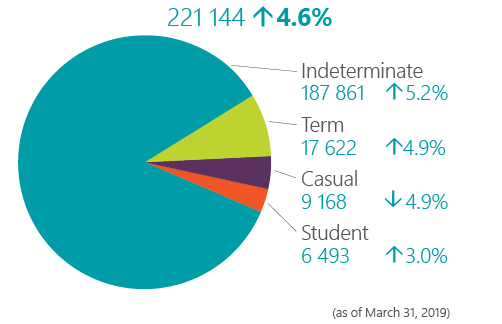
Text Alternative
| Tenure | Population | Percentage of population (%) | Year-over-year change in population (%) |
|---|---|---|---|
| Indeterminate | 187 861 | 84.9% | +5.2% |
| Term | 17 622 | 8.0% | +4.9% |
| Casual | 9 168 | 4.1% | -4.9% |
| Student | 6 493 | 2.9% | +3.0% |
| Total | 221 144 | 100% | +4.6% |
Did you know?
More than 5 000 students were also hired by departments and agencies not subject to the Public Service Employment Act.

Experimenting with student hiring
Departments and agencies are exploring innovative approaches to attracting highly skilled university and college students, recognizing the need to engage early with potential candidates and create a positive recruitment experience. For example, Statistics Canada organized the first edition of the CANDEV Data Challenge Series, bringing together 14 federal departments, about 250 post-secondary students from across Canada and key representatives from the University of Ottawa. Departments provided current business problems, and participants had 24 hours to solve them, using open data and experimenting with leading-edge technologies to produce a variety of prototypes. These innovative models have great potential to be further developed. More importantly, the event resulted in nearly 110 students applying to a targeted Federal Student Work Experience Program advertisement, leading to 18 student hires across several departments during the 2018 winter and 2019 summer semesters.
Hiring for current and future public service jobs
While the nature of work is shifting, this has not yet significantly altered the types of jobs for which the federal public service is hiring. Almost half of all hires continued to be within the clerical, administrative services and program administration fields. However, driven by technological advancements and escalating expectations for digital services, the Computer Systems group continued to grow, with external hiring into this group increasing by 71% over last year. Executive level hiring from outside the public service also increased, by 13.9% to 115 hires, bringing in mid-career professionals with valuable experience and ideas to navigate the future of public service work.
Public service population – Top 5 occupational groups Endnote E2
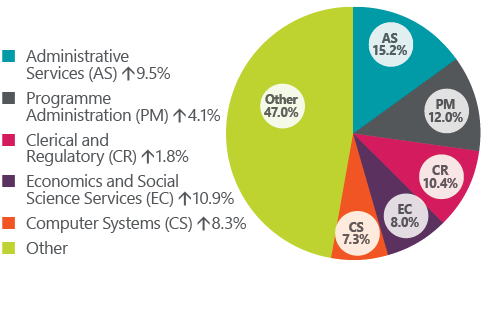
Text Alternative
| Occupational group | Percentage of all indeterminate and term population (%) | Year-over-year change in indeterminate and term population (%) |
|---|---|---|
| AS - Administrative Services | 15.2% | +9.5% |
| PM - Programme Administration | 12.0% | +4.1% |
| CR - Clerical and Regulatory | 10.4% | +1.8% |
| EC - Economics and Social Science Services | 8.0% | +10.9% |
| CS – Computer Systems | 7.3% | +8.3% |
| Other | 47.0% |
Public service hiring – Top 5 occupational
groups Endnote E2

Text Alternative
| Occupational group | Percentage of all indeterminate and term hiring (%) | Year-over-year change in indeterminate and term hiring (%) |
|---|---|---|
| AS - Administrative Services | 16.3% | +33.2% |
| PM - Programme Administration | 10.0% | +5.2% |
| CR - Clerical and Regulatory | 23.4% | +10.9% |
| EC - Economics and Social Science Services | 8.0% | +23.6% |
| CS – Computer Systems | 6.9% | +71.0% |
| Other | 35.4% |
Shifting how the public service works and how it recruits

As the federal public service recruits, it must adapt to changing expectations and ways of working. New career paths are emerging, with a growing number of employees wanting to contribute specific skills and talents beyond their position, sometimes preferring short-term assignments to long-term programs, and with increased interest in working on virtual teams. Enabled by technology, the public service will make growing use of varied work arrangements, accessing more diverse pools of skills and abilities, both inside and outside the public service. Technology and new models for employing talent are redefining the workplace; they also provide an opportunity to foster a representative and inclusive workforce that benefits from innovative and diverse perspectives.
These changes in how the public service works will inevitably lead to shifts in how it recruits. As a result, we will need to pay particular attention to temporary hiring, and to explore any trends in this potentially precarious workforce. For example, significantly more women than men are hired into term and casual positions. The Public Service Commission will conduct more research to better understand factors contributing to this situation, and ensure that workforce representation is considered across all types of hires.
Staffing within the federal public service
The Public Service Commission of Canada also oversees appointments that take place within the public service. In 2018–19, just over a quarter of public servants changed roles due to a promotion, acting appointment or lateral move.
The promotion rate increased for the 6th year in a row to 12.5%, or 25 618 promotions.
Close to 12% of employees moved laterally across the public service, and 8 305 term employees were converted to indeterminate status — a 25.7% increase since 2017–18.
Internal mobility ratesEndnote E3
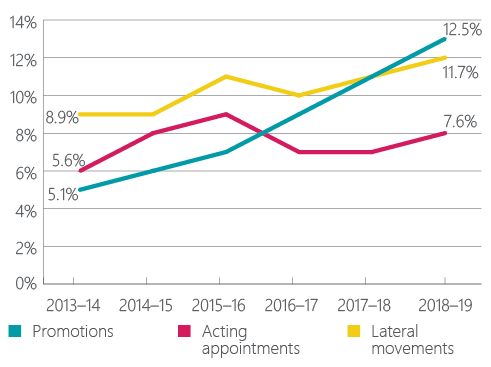
Text Alternative
| Fiscal year | 2013 to 2014 | 2014 to 2015 | 2015 to 2016 | 2016 to 2017 | 2017 to 2018 | 2018 to 2019 |
|---|---|---|---|---|---|---|
| Promotion rate | 5.1% | 6.1% | 7.4% | 9.3% | 10.6% | 12.5% |
| Acting appointment rate | 5.6% | 7.8% | 8.5% | 6.6% | 6.7% | 7.6% |
| Lateral movement rate | 8.9% | 8.9% | 10.5% | 10.2% | 11.3% | 11.7% |
We have found that students are increasingly being hired through casual placements as opposed to established student programs, with a 79.7% surge between 2014–15 and 2018–19. We want to ensure that this practice is not caused by challenges in administering student programs, or by managers hiring known individuals at the expense of fair access to all students. We must also ensure that this situation does not create inequity in the workplace. Additional research as well as the soon-to-be launched Horizontal Audit of Student Hiring Under the Federal Student Work Experience Program will shed further light on these issues.
While each department and agency must determine the best balance of indeterminate, term, casual and student populations for effective and efficient service delivery, these staffing mechanisms should be used appropriately, and with full consideration of their effects.
Advancing diversity and inclusion
The public service must reflect the population it serves; all individuals must have equal opportunity to fully contribute, and the recruitment process needs to be barrier-free. This is a shared responsibility across central agencies and departments, and it requires concerted effort. In 2018–19, departments and agencies demonstrated commitment to building inclusive workplaces and finding innovative approaches to attracting and hiring diverse talent. There were also consistent shortcomings that are a continued cause for concern: for the fifth year in a row, persons with disabilities applied at rates lower than their workforce availability, and for 4 of the past 5 years, Aboriginal peoples applied at rates below their workforce availability. Every effort must be made to close these gaps.
Promoting diversity in student hiring
To support departments and agencies in building future skills, and to enable all Canadians to envision a public service career, the Public Service Commission continues to manage student programs for employment equity groups.
The Indigenous Student Employment Opportunity provides Indigenous students with work experience close to where they live or go to school. It also launches a relationship that can lead to a career with the public service. For the summer of 2019, 1 174 students applied to the program. Of these applicants, departments and agencies hired 226 Indigenous students across the country, up from 186 in 2018.
The Employment Opportunity for Students with Disabilities aims to create positive early work experiences for students with disabilities, and encourages them to consider a career in the public service by highlighting potential pathways and available support. The program resulted in 115 hires for the summer of 2019, up from 61 in 2018. Although this is an increase, departments and agencies did not take full advantage of the program, leaving 1 456 students who were not hired. Managers may see hiring persons with disabilities as complicated and costly. If the federal public service is to meet Accessible Canada Act targets, this is an area for concern. Hiring managers and human resources professionals need to learn more about the program and how it can serve their recruitment needs.
Employment equityEndnote E4
Applicants to advertised processes, compared to 2011 workforce availability

Text Alternative
| Persons with disabilities | Aboriginal peoples | Members of visible minorities | Women | |
|---|---|---|---|---|
| Applicants | 2.7% | 3.0% | 22.3% | 55.0% |
| 2011 workforce availability | 4.4% | 3.4% | 13.0% | 52.5% |
Did you know?
The Public Service Commission of Canada’s Personnel Psychology Centre works with departments and agencies to enhance fairness in the assessment process, so that people with disabilities can fully demonstrate their qualifications. In 2018–19, the centre provided guidance in response to nearly 3 000 requests from departments for assessment accommodation.
Most situations benefit from more than one recommendation, including:
- extra time
- alternative formatting
- one-on-one (rather than group) assessment
Introduction to the Personnel Psychology Centre
How departments and agencies are diversifying recruitment
While our programs are one entry point into the federal public service, department-specific recruitment efforts account for most employment equity group hiring. For example, Agriculture and Agri-Food Canada's Indigenous Support and Awareness Office aims to enhance departmental representation of Indigenous peoples by delivering cultural awareness training across the department, providing workplace support for Indigenous employees and students and overseeing the Indigenous Student Recruitment Initiative. The office is predominately staffed with Indigenous employees, including the first and only full-time Elder in the federal public service. Employees are supported on an ongoing basis by the Elder, and students receive additional support from 2 Indigenous student career and cultural advisors. As a result of the Indigenous Student Recruitment Initiative, 65 Indigenous students were hired into summer positions and 6 were hired on a permanent basis in 2018–19.
Employment and Social Development Canada diversified its approach to attracting talent, exploring different ways to hire for potential and draw on skilled candidates from outside traditional recruitment catchment areas. The department worked with Indigenous partner organizations to identify and hire Indigenous people in the IT field. It created plain-language job posters and shared them with these partners, who then compared their clients’ skills against those in the posters. Clients with the required skills were then sent to the IT branch for right-fit assessment. As a result of this initiative, the department hired 30 Indigenous people, including 7 students, into IT positions between January 1 and December 31, 2018.
Public Services and Procurement Canada collaborated with Ready, Willing and Able and its local delivery partner, Autism Nova Scotia, to recruit for positions in their Atlantic offices. The team harnessed the strengths and talents of job seekers on the autism spectrum to fill positions that required skills not common in neuro-typical job seekers. The department’s innovative approach to recruitment included a working interview, where candidates performed the duties that would be part of the job instead of simulations or tests, which helped determine right fit for the positions. Several managers and employees also completed training on autism in the workplace and integrated best practices for employment supports. To date, this collaboration has resulted in 3 hires and established a model that other departments and agencies can follow to create a more inclusive public service.
Attracting, retaining and developing members of employment equity groups
While these recruitment efforts are promising, the public service also needs to retain and develop this talent. To better understand the career progression of employment equity group members, we conducted the Employment Equity Promotion Rate Study. This study highlighted progress in promotion rates across groups, but it also identified some significant gaps:
- the rate for women has improved in recent years, but it remains lower than that of men in scientific, professional and technical occupations
- rates for persons with disabilities and Aboriginal peoples have also improved, but they remain lower than those of their respective counterparts
- rates into and within the EX group are lower for members of visible minorities compared to those of their counterparts
This study is a starting point. We have uncovered some issues, but still need to fully understand the “why.” We will continue to provide policy, services and program support to help ensure that employment equity group members are given equal opportunities for promotion in the federal public service.
Beyond the Employment Equity Act
While meeting representation levels remains a key focus, the public service is looking beyond the 4 groups identified in the Employment Equity Act to expand current views of diversity and develop a workforce that is inclusive of “the array of identities, abilities, backgrounds, skills, perspectives, and experiences that are representative of Canada’s current and evolving population” (Many Voices, One Mind: A Pathway to Reconciliation).
We continue to experiment with different initiatives to appeal to diverse groups. For example, in 2018–19, we started modernizing our approach to collecting and using sex and gender information in order to be inclusive and respectful of transgender, non-binary and 2-spirit people, as well as to monitor any potential barriers to job opportunities in the federal public service. In 2018–19, we also began integrating a gender-based analysis plus (GBA+) lens into our key initiatives. Applying a GBA+ lens will ensure that we consider and address the potential impacts of our decisions on different groups of the population (that is, based on factors including gender, ethnicity, sexual orientation, geographic area, and mental or physical disability) as systematically as possible when we develop and implement policies, programs and services.
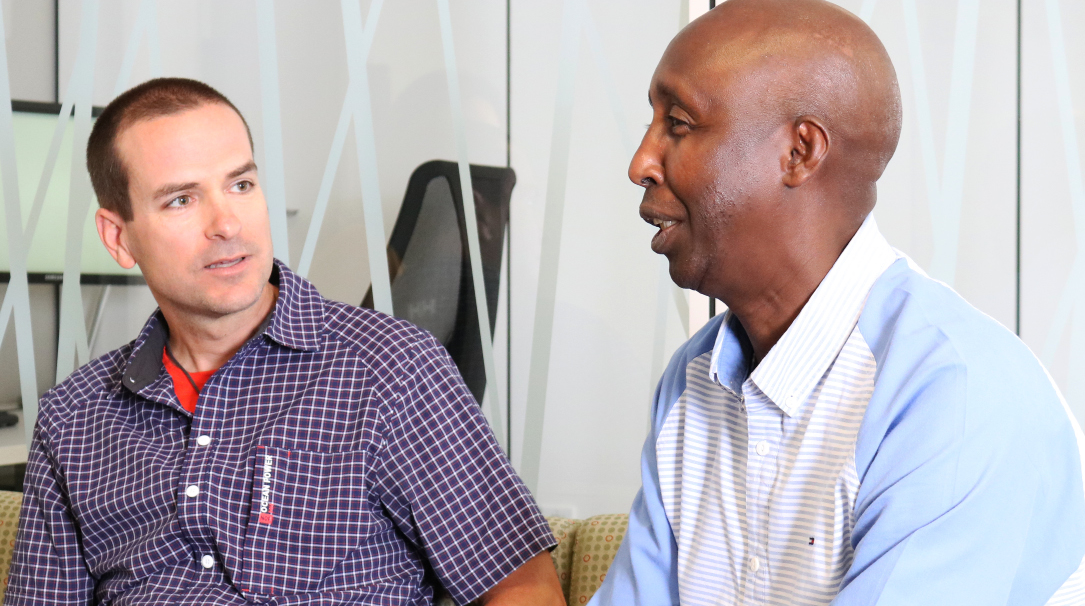
Regional representation
Regional hiring contributes to a diversity of perspectives and to public service excellence. As of March 31, 2019, hiring in all regions outside of the National Capital Region combined increased by 6.2%, and the total population (indeterminate, term, casual and student) was up across all regions except Nunavut. Despite this growth, the regional population as a percentage of the workforce has been in decline — from 56% 5 years ago to 53% in 2018–19.
All Canadians, regardless of where they choose to live, should have equal access to public service jobs. In 2018–19, 69.1% of all external indeterminate and term hires from advertised processes were of applicants from outside the National Capital Region. This share has been steadily decreasing since 2013–14, when it was 79%. Technological advances and changing workplace culture may enhance regional hiring and the type of work done in the regions. The public service must explore and leverage these opportunities to attract and hire more regional candidates.
| Region | Hires | Public Service Employment Act population*Footnote * |
|---|---|---|
| 1. British Columbia | 3 761 | 17 985 |
| 2. Alberta | 2 375 | 11 297 |
| 3. Saskatchewan | 1 006 | 4 863 |
| 4. Manitoba | 1 361 | 7 033 |
| 5. Ontario (except NCR) | 4 595 | 26 199 |
| 6. National Capital Region (NCR) | 30 074 | 103 384 |
| 7. Quebec (except NCR) | 5 430 | 23 012 |
| 8. New Brunswick | 2 249 | 8 579 |
| 9. Nova Scotia | 2 733 | 9 425 |
| 10. Prince Edward Island | 629 | 2 072 |
| 11. Newfoundland and Labrador | 919 | 3 488 |
| 12. Yukon | 72 | 320 |
| 13. Northwest Territories | 88 | 426 |
| 14. Nunavut | 79 | 245 |
| 15. Outside Canada | 83 | 1 433 |
| Unknown | 4 263 | 1 383 |
|
||

Supporting bilingualism
Serving Canadians in the official language of their choice is an integral part of program and service delivery. The Public Service Commission plays an important role by supporting departments and agencies in hiring bilingual employees, conducting 99 459 second language evaluations in 2018–19. We also work with official language minority communities across Canada to promote linguistic duality and to better understand their needs and challenges.
We attended 40 outreach events to engage academic institutions and associations in official language minority communities in 2018–19.

Building inclusive workplaces
To stimulate diversity in the workforce, the Public Service Commission of Canada, in partnership with the Quebec Federal Council, held an interdepartmental recruitment event to attract members of visible minorities and language minority communities in Quebec.
With a number of entry and mid-career level opportunities offered by 5 departments, the event resulted in:
- 2 510 candidates
- 42% self-declared as belonging to a visible minority group
- 37% identified English as their first official language
- 13 on-the-spot conditional job offers
- 31 individuals qualified for future opportunities
This event also led to the creation of Jury+, a new tool that fosters diverse and representative assessment committees and improves the candidate experience. The tool lists 134 public servants who are members of employment equity groups and/or language minority communities, and who are available to participate on assessment boards.
Persons with a priority entitlement and veterans
Priority entitlements are rights provided for under the Public Service Employment Act and the Public Service Employment Regulations to help public servants cope with career changes and life events. Of the 11 types of priority entitlements, the 3 largest categories in 2018–19 were:
- medically released veterans (37%)
- people returning from extended leave (33%)
- individuals relocating with their spouse or common-law partner (17%)
By providing greater access to job opportunities, priority entitlements help public servants remain in the federal public service, and they help departments and agencies retain skilled employees. Under the Public Service Employment Act, a manager must hire a qualified person with a priority entitlement before all others. Persons with a priority entitlement provide a pool of individuals who can be appointed quickly.
In 2018–19, 721 persons with a priority entitlement were appointed, continuing a decline over the last 2 years. Given the increase in overall hiring, the public service’s collective inability to secure placements for these valuable resources must be challenged.
We will continue to raise awareness of the provisions that help persons with a priority entitlement, and to provide advice and guidance to public service managers and human resources staff.
Priority entitlements: population and appointments
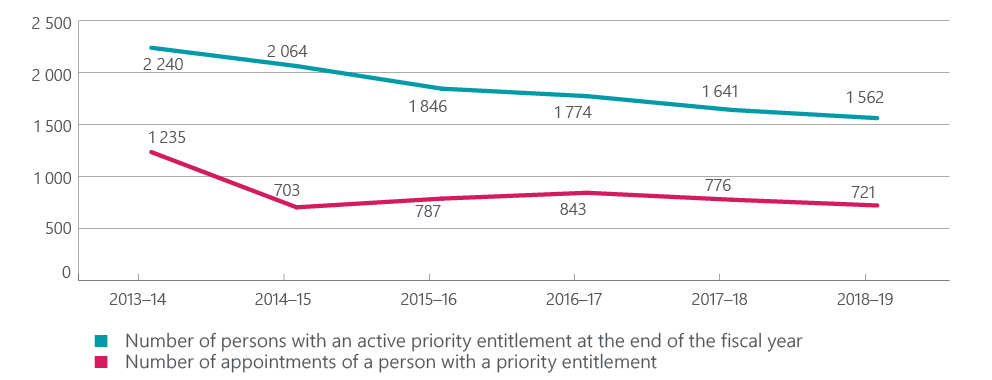
Text Alternative
| Fiscal year | 2013 to 2014 | 2014 to 2015 | 2015 to 2016 | 2016 to 2017 | 2017 to 2018 | 2018 to 2019 |
|---|---|---|---|---|---|---|
| Number of persons with an active priority entitlement at the end of the fiscal year | 2 240 | 2 064 | 1 846 | 1 774 | 1 641 | 1 562 |
| Number of appointments of a person with a priority entitlement | 1 235 | 703 | 787 | 843 | 776 | 721 |
In December 2018, the Public Service Commission of Canada launched an Orientation Program for Persons with a Priority Entitlement. The program helps persons with a priority entitlement, including veterans, maximize their chances of finding a public service job. It includes how-to videos, tips and orientation sessions on understanding and making full use of priority entitlements. These sessions are offered regularly across the country, in person and online. As of the end of March 2019, 13 of these sessions were held across Canada; 8 at Public Service Commission offices and 5 at Canadian Armed Forces bases.
Veterans
Canada’s veterans are a valuable source of talent, knowledge, skills and experience. On July 1, 2015, the Veterans Hiring Act amended the Public Service Employment Act to help qualified Canadian Armed Forces members and veterans transition into federal public service positions. Since then, the population of medically released veterans continues to rise, numbering 571 individuals as of March 31, 2019. Between 2015–16 and 2018–19, the number of Canadian Armed Forces members with a priority entitlement grew by 40%. In 2018–19, 226 medically released veterans were appointed as a result of a priority entitlement, bringing the total number of medically released veterans appointed since 2015 to 799.
Some departments and agencies have been actively hiring veterans. However, as a whole, the public service needs to do more to retain veterans who want to continue to serve Canadians after their military career. Although not part of the core public administration, the Canada Revenue Agency voluntarily mirrored the Public Service Employment Act’s preference, mobility, and statutory Canadian Armed Forces medically released priority provisions, and has appointed 34 veterans with a priority entitlement since 2015.
The majority (88%) of veterans with a priority entitlement are located outside of the National Capital Region. Since 2015, most departments and agencies that have hired more than 10 veterans with a priority entitlement also have a large regional presence. We encourage other departments and agencies with a strong regional presence to model the Canada Revenue Agency’s success in supporting veteran hiring.
Did you know?
The Department of National Defence is by far the biggest recruiter of veterans, with 514 appointments since 2015.
2018–19 appointments of veterans
478
-13.1%
| Priority entitlement | 226 | -4.6% |
|---|---|---|
| Mobility | 134 | -30.6% |
| Preference | 118 | +2.6% |
Modernizing public service staffing
Progress has been made since the new staffing policy framework — the New Direction in Staffing — came into effect in 2016. More managers are working strategically with their department’s human resources professionals to attract and hire new talent, yet opportunities remain to use the new policy framework to modernize and streamline staffing processes. The Public Service Commission of Canada is committed to working with partners to facilitate innovation and experimentation and spur an important shift in mindsets and behaviours. Simple changes, such as using easy-to-understand language in job advertisements, can have a big impact, especially for Canadians with no public service experience. Sharing pools of qualified candidates is another improvement that can produce tangible results.
Reducing time to staff
Public Service Employment Act – Median time to staff*Endnote E5
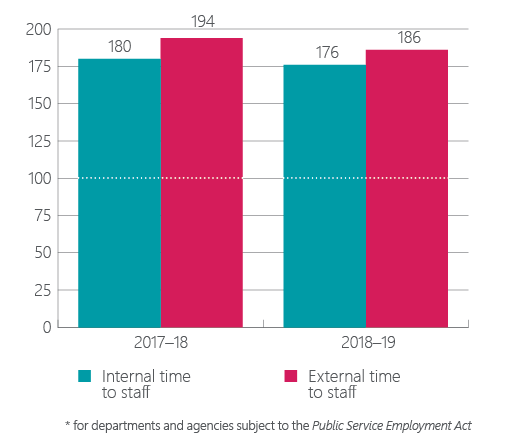
Text Alternative
| Fiscal year | Internal time to staff | External time to staff |
|---|---|---|
| 2017 to 2018 | 180 days | 194 days |
| 2018 to 2019 | 176 days | 186 days |
Low unemployment and labour shortages in key areas mean that the public service is competing for the best and the brightest. In this environment, lengthy staffing processes can impede the public service’s ability to hire top talent. The median time that it takes to hire a new employee to the public service using a process that is open to all Canadians decreased by 8 days, from 194 days in 2017–18 to 186 days in 2018–19. This is an improvement, but it is not enough if the public service is to effectively compete for talent. We are committed to working with departments and agencies to find ways to reduce time to staff in the federal public service.
Initiatives such as the Canadian Space Agency’s virtual external staffing pilot have resulted in significant reductions in time to staff. The pilot used online assessments of knowledge and skills, as well as virtual discussions with successful candidates, reducing time and effort to assess candidates by 70%. The approach is now being adapted to other staffing processes within the agency.
Statistics Canada used a new assessment method, allowing candidates to self-assess their qualifications, with managers and directors verifying the results. Combined with performance appraisals, the approach has cut time to staff in half, while also significantly increasing the number of qualified candidates, including those in employment equity groups.

Making it easier to find public service jobs
Beyond the time it takes to staff a position, the application experience is crucial to engaging candidates, and with more than 11 million views of our GC Jobs website in 2018–19, there are many job seekers to satisfy. This year we made it easier for Canadians to find jobs on Canada.ca. We drew on web analytics and trends analysis to re-design our pages, and worked with students who had never before applied to GC Jobs to:
- identify problem areas
- design an improved prototype
- eliminate unnecessary landing pages
- replace unclear language and jargon with clear language
As a result of this work, the ability to successfully find a job posting on Canada.ca improved from 56% to 94%.
Leveraging the New Direction in Staffing
The Canadian Coast Guard’s Marine Communications and Traffic Services program used the flexibility of the New Direction in Staffing to modify their recruitment strategy for difficult-to-staff officer positions in the Central and Arctic region. Coast Guard officers acted as ambassadors, visiting career fairs and high schools in coastal and northern areas to promote career opportunities with the department. Using local and social media, they generated interest for in-person test preparation and recruitment testing sessions.
They also adapted the standard recruitment process to take advantage of the in-person nature of the recruitment events: testing took place before applicants applied through GC Jobs. This approach resulted in a 300% increase in qualified candidates over 2 years (from 20 to 80 a year), and a decrease in vacancies, from 36 to 21, with a projected further decrease to 8 by March 2020.

Transforming GC Jobs – modernizing recruitment in the federal public service
To enhance the experience of job seekers and to modernize hiring, we continue to work on transforming GC Jobs. This year we invited recruitment companies to demonstrate potential recruitment systems. We will draw on their proposals to develop a solution that provides job seekers with a more direct and accessible way to find and apply to government jobs. We are building the new solution on the principle of inclusivity and taking it into the digital age, basing it on Government of Canada Digital Standards. The resulting solution will provide all Canadians with better access to federal public service jobs, and help hiring managers to find crucial talent in a timely way.
Creating and sharing business intelligence tools
Now more than ever, the public service relies on quality data when making decisions. Evidence-based decision making can shape staffing strategies and greatly improve the likelihood of success of recruitment activities. We are developing and sharing business intelligence tools to help departments and agencies succeed, including macro-simulations to meet specific hiring targets, and a forecasting tool that allows managers and staffing advisors to predict the volume of applications to job advertisements.
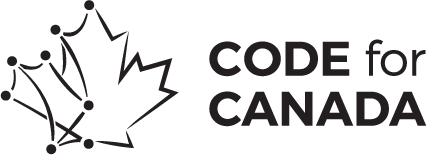
Code for Canada
The Public Service Commission of Canada worked with Code for Canada, a not-for-profit organization that embeds technology and design professionals in government organizations to work alongside public servants on digital transformation projects. The project team developed a modern, electronic managerial in-box exam to replace paper-based in-basket exams. This new assessment tool simulates an email inbox. Candidates respond to a series of emails depicting situations often encountered by managers in the federal public service. These situations allow the candidates to demonstrate key leadership competencies. The project team engaged with users to build an accessible application that hosts the new tool. The Public Service Commission will develop, test and integrate the new tool with existing systems in 2019–20.
A public service based on merit and non-partisanship
For more than 110 years, the Public Service Commission of Canada has safeguarded merit-based appointments and non-partisanship in the public service. Alongside our renewed policy framework, we enhanced our oversight model to balance system-wide oversight and departmental monitoring. This new model draws on a range of tools to assess the health of the staffing system, including system-wide as well as targeted risk-based audits, the Staffing and Non-Partisanship Survey, studies and investigations. We investigate staffing irregularities in external appointment processes, allegations of political influence and fraud in internal and external appointment processes, and improper political activities.
Perceptions of staffing: fairness, merit and workload burden
Fiscal year 2018–19 also marked the first gauge of employee perceptions since the New Direction in Staffing was implemented. The Staffing and Non-Partisanship Survey captured the views of over 100 000 employees, hiring managers and human resource professionals. Some of the results of the survey are concerning. For example, only 53.8% of employees indicated that people hired in their work unit can do the job, and less than half of employees (46.4%) viewed staffing as fair. The perception of fairness was even lower for persons with disabilities, Indigenous peoples and members of visible minorities. Although there may be many factors contributing to this perception of fairness, insufficient communication of staffing intentions and decisions to employees may play a part.
As well, in stark contrast to the new policy framework’s intended simplification of staffing, 87.9% of managers still feel that the staffing process is burdensome. Departments and agencies were asked to shift their staffing processes and practices with the implementation of the New Direction in Staffing in 2016, and while this culture change will take time, they should continue to review their practices to address any deficiencies and increase the confidence of employees and managers in staffing fairness and efficiency.
While the survey shows that more employees believed merit was not being met, since the coming into force of the new policy framework, the number of founded investigations has been in decline.

Did you know?
While the authority to investigate staffing irregularities in internal appointment processes lies with deputy heads, they can ask the Public Service Commission of Canada to investigate on their behalf.
Investigations
In 2018–19, we received 563 requests for investigations. Of these requests:
- 250 fell under our mandate — this included 6 deputy head requests for internal appointment investigations
- 154 related to error, omission or improper conduct, or to merit not being met
- 78 related to fraud
- 18 related to improper political activities
- none related to political influence
Number of founded investigations cases
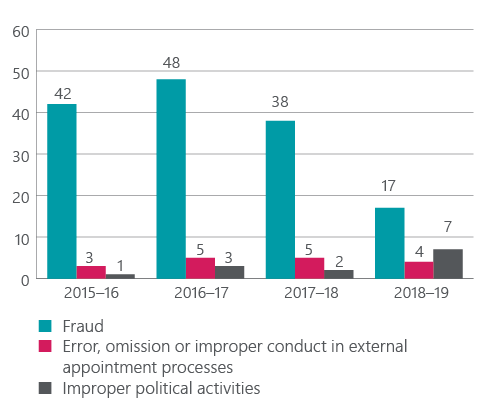
Text Alternative
| Fiscal year | 2015 to 2016 | 2016 to 2017 | 2017 to 2018 | 2018 to 2019 |
|---|---|---|---|---|
| Fraud | 42 | 48 | 38 | 17 |
| Error, omission or improper conduct in external appointment processes | 3 | 5 | 5 | 4 |
| Improper political activities | 1 | 3 | 2 | 7 |
Credential validation
We also conducted a Horizontal Audit on Credential Validation to explore whether public servants had obtained the necessary level of education for their position when they were hired. The audit results were positive, with proof of education verified for the vast majority of files. We did uncover a weakness in obtaining Canadian equivalency for some foreign credentials, and we will work with the Office of the Chief Human Resources Officer and departments and agencies to address this.
Departmental monitoring
Our oversight is complemented by departmental monitoring. We have asked all departments and agencies to assess the health of their own systems at least every 5 years, and to report to us on the results. Since the implementation of the New Direction in Staffing, 6 departments have provided us with a cyclical assessment report. These results show that departments have adapted the monitoring of their staffing system to their own needs and organizational context, and are complying with key policy and legislative requirements.
Committed to Open Government
This year the Public Service Commission of Canada released results from the Staffing and Non-Partisanship Survey and developed a first-of-its-kind interactive data visualization tool that allows users to easily manipulate the survey data to meet their needs.
Since the tool and a new online engagement strategy were implemented, interest in the Public Service Commission’s open datasets has surged — with more downloads, comments and inquiries.
Exchange on Staffing Oversight November 2018
To help departments and agencies enhance their monitoring, the Public Service Commission of Canada hosted the “Exchange on Staffing Oversight.” The half-day event brought together nearly 100 representatives from the human resources and internal audit communities to discuss roles, responsibilities and approaches to staffing oversight — including strategies for capacity building, partnerships and collaboration.
Non-partisanship and political activities
Non-partisanship is a cornerstone of Canada’s impartial, professional public service. The Public Service Employment Act recognizes the right of public servants to engage in political activities as long as those activities do not impair, or are not perceived as impairing, the ability of public servants to perform their duties in a politically impartial manner.
Political activities and public servants
Under the Act, a political activity is any activity in support of, or in opposition to, a political party or a candidate. Seeking nomination as, or being, a candidate in an election is also a political activity.
The Staffing and Non-Partisanship Survey results indicate that most employees (80.1%) understand their rights and obligations, and are able to make informed decisions about engaging in political activities (88.5%). Although the survey results are positive, we continue to work to ensure that public servants are aware of their rights and obligations related to political activities. In 2018–19 we held information sessions for public servants throughout the country to raise awareness, tailoring sessions to managers, labour relations and human resources officers, and values and ethics advisors. Public servants can also use our Political Activities Self-assessment Tool to make informed decisions about engaging in political activities.
Candidacy in elections
Before seeking nomination or being a candidate at the municipal, territorial, provincial or federal level, public servants must first request and obtain permission from the Public Service Commission of Canada. In deciding whether these activities will impair or be perceived as impairing an employee’s ability to perform their duties in a politically impartial manner, we consider factors such as the nature of the election and the employee’s duties, as well as the level and visibility of the employee’s position. If permission is granted, we may set out conditions to avoid or to mitigate potential risks to political impartiality.
| Level | Number of elections* | Number of permissions granted |
|---|---|---|
| Municipal | 9 | 56 |
| Territorial | 0 | 0 |
| Provincial | 3 | 13 |
| Federal | 0 | 12 |
| Total | 12 | 81 |
*Refers to elections where a public servant sought permission
In 2018–19, we granted 81 requests for permission. One request was denied following analysis of the potential of perceived risk to political impartiality. Measures could not be implemented to mitigate the potential risk associated with the public servant’s duties, particularly the degree of influence over the drafting of legislative texts and the interactions with political staff.
During this same time period, we received 18 allegations of improper political activities — most concerned a failure to seek and obtain permission before running for office. Twelve cases warranted an investigation; 7 investigations reached a founded conclusion and appropriate corrective actions were ordered.


Moving forward
We must continue to strive to build a talented, inclusive and diverse public service that is representative of all Canadians.
With the coming into force of the Accessible Canada Act and the Accessibility Strategy for the Public Service of Canada, we look forward to collaborating on innovative pilots and solutions across government to identify, remove and prevent accessibility barriers, and to increase the representation of persons with disabilities. In this context, we are currently implementing the Federal Internship Program for Canadians with Disabilities to offer 125 2-year internship placements over the next 5 years.
In October 2018, we launched an Audit of Employment Equity Representation in Recruitment. The audit reviews a sample of externally advertised term and indeterminate selection processes across 30 departments to identify factors that may affect employment equity representation throughout key stages of the recruitment process. We look forward to sharing the results in 2019–20 and identifying opportunities to improve diversity within the public service.
Amidst the demand for more inclusion and engagement, based in no small part on social change, technological innovation will advance unabated and will continue to reshape the workforce. The need for digital skills is only becoming more prevalent, as competencies such as creativity and problem-solving remain key. Hiring for potential is becoming more important, and the public service must continue to look at innovative ways to attract, assess, hire and retain skilled workers in the face of continued competition, both at home and abroad. And in doing so, we must continue to drive towards more efficient, timely hires.
We are exploring the use of emerging technologies to improve recruitment. For example, together with Employment and Social Development Canada, we are researching the potential of artificial intelligence in the staffing process, keeping in mind privacy and ethical considerations. We are also piloting a project with the National Research Council of Canada to leverage artificial intelligence to assess the quality of translation and official language equivalence of job advertisements.
We are currently exploring new recruitment solutions offered by industry. This is another step towards the transformation of the GC Jobs website, which will result in an inclusive, intuitive and effective platform that will provide all Canadians with better access to federal public service jobs, while significantly reducing the time it takes to staff positions.
Technology alone will not solve the riddle of complex staffing, nor prepare us for the future of work. Unless the mindsets of all stakeholders undergo a profound shift, we will be unable to fully realize the benefits of modernized public service hiring. We remain committed to working with all departments and agencies to harness the New Direction in Staffing to redefine our approach to recruitment, and achieve a system-wide change for attracting the talent required to successfully serve Canadians.
In this evolving landscape, the Public Service Commission of Canada’s role is more crucial than ever, both to ensure that merit and non-partisanship are upheld, and to bring about the modernization required to build tomorrow’s public service, today.
Unless stated otherwise, all data reflects 2018–19 population and staffing activities to and within departments and agencies subject to the Public Service Employment Act. This does not include separate agencies such as the Canada Revenue Agency, the Canadian Food Inspection Agency and Parks Canada.
Additional information is available on the Open Government portal.
For more information, please contact:
The Public Service Commission of Canada
22 Eddy Street, Gatineau, Quebec K1A 0M7
cfp.infocom.psc@canada.ca
Twitter: @PSCofCanada
This report is also available on our website at https://www.canada.ca/en/public-service-commission.html
Catalogue No.: SC1E-PDF
ISSN: 1912-0842
© Her Majesty the Queen in Right of Canada, represented by the Public Service Commission of Canada, 2019